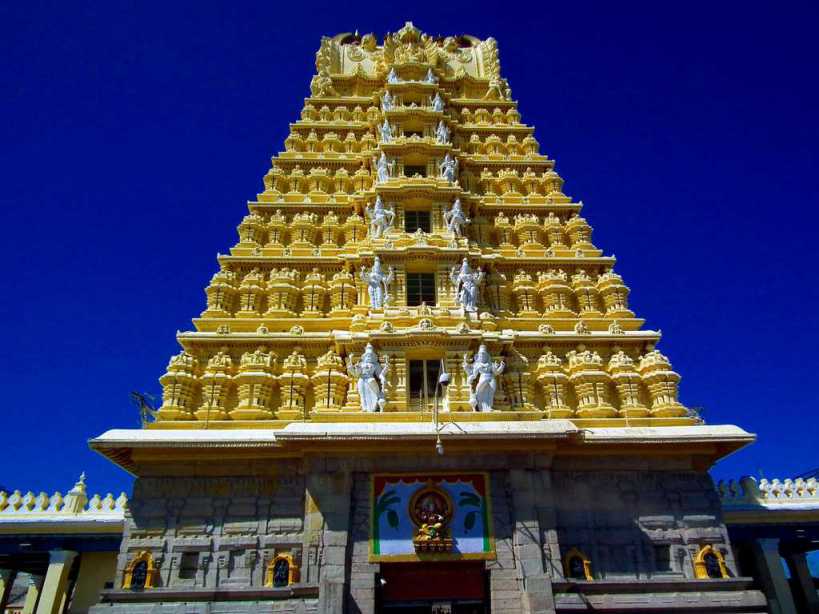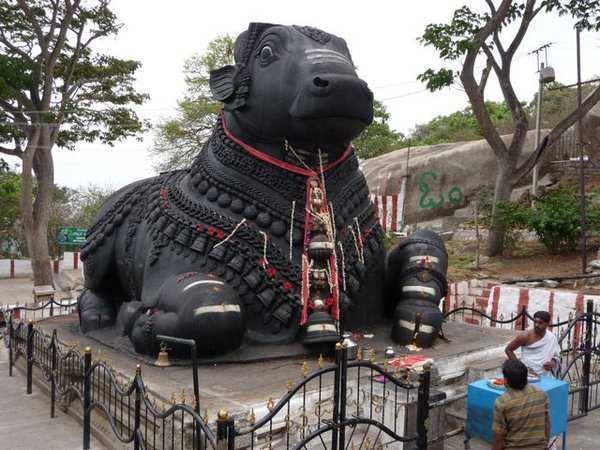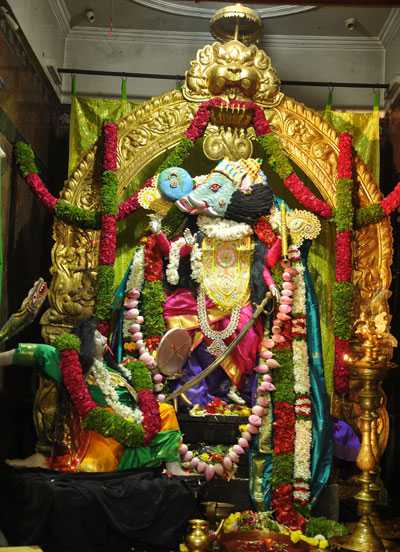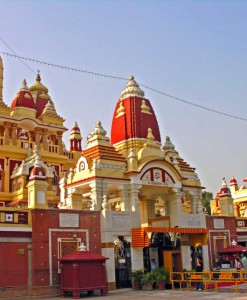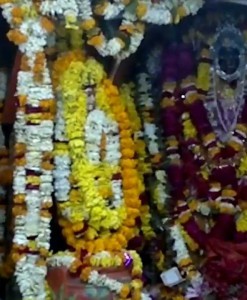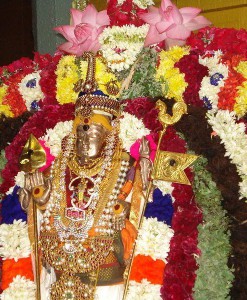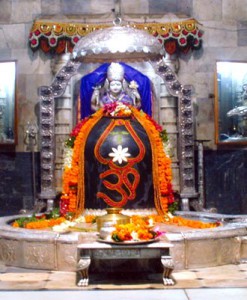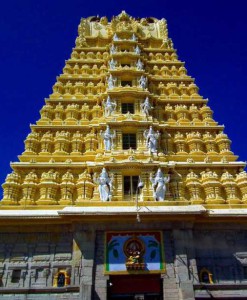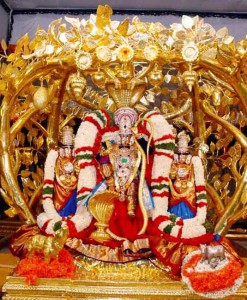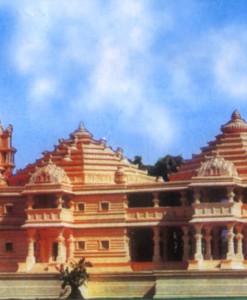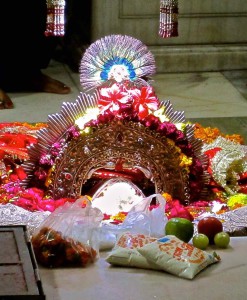No products in the cart.
Sri Chamundeshwari temple is the most famous temple in Mysore, a city in the Southern state Karnataka. It is located on the top of Chamundi hill which is about 3,489 ft. above sea level and situated at a distance of 13 kms from Mysore. Named after the Goddess Chamundeshwari or Durga, this temple is considered as one of the Shakti Peethas. It is known as Krouncha Pitham.
The temple stands as a beautiful example of the Dravidian architecture. It has a quadrangular structure. The temple consists of Main doorway, Entrance, Navranga Hall, Antharala Mantapa, Sanctorum and Prakara. A graceful seven-tier Gopura or pyramidal tower stands at the entrance and a Vimana which is a small tower, atop the sanctum sanctorum. On the ‘Shikara’, the tower at the entrance, are seven golden ‘Kalashas’. A small statue of Lord Ganesha stands in the doorway. The doorway is silver-plated and has the images of Goddess Durga in different configurations on it. After climbing a few steps one sees a flagstaff, the footprints of the Goddess and a small statue of Nandi, facing the sanctum sanctorum.On the right side, before approaching the flag staff, there is an image of ‘Anjaneya’, attached to the wall. On either side of this entrance are two Dikpalakas. In the sanctum sanctorum is the stone statue of The Divine Goddess that is decorated every day and is worshipped by a number of priests. The ‘Mahisha Mardhini’ rests on a throne with ‘Ashta Bhujas’ i.e. 8 shoulders. According to the local legend, the image was established by sage Markandeya and hence it dates back to an old era. In the room in front of the sanctum sanctorum, there is a magnificent 6-foot statue of Maharaja Krishnaraja Wodeyar III.
The magnetism for the devotees also lies in the Nandi statue, apart from the Divine Mother’s grace. Nandi (bull), mount of Lord Shiva, is beautifully sculpted into a black granite statue which is 16 feet tall. This Nandi of Mysore is the 3rd largest Nandi in India. The decorative pendent bells around its neck are exquisite.
Sri Chamundeshwari Temple, Mysore
The temple is dedicated to the Goddess ‘Chamundi’ or Durga who is a fierce form of Shakti. She is the enforcer of demons, Chanda and Munda, and also ‘Mahishasura’ the buffalo headed monster. Hence she got the names, ‘Mahishasuraghati’ and ‘Mahisha Mardini’. Mysore was ruled by the demon-king Mahishasura. Hence, came the name of this place – Mahishuru, the city of demon Mahisha. Acknowledging to the prayers of Gods and Goddess to save them from the monster, Goddess Parvathi, Consort of Lord Shiva, reincarnated as Chamundeshwari and killed the monster. After killing the demon, the Goddess resided atop the Chamundi Hills where she is worshiped with reverence and devotion. The entire hill, where the temple is established was named after her in honor of her victory and courage.
Goddess Durga was considered as the Family Deity of the Mysore Kings. Historians assert that the temple was established in the 12the Century by the Hoysala Kings, but the temple tower was built in the 17th Century by the Vijaynagar Royals. Evidences state that Hoysala King Vishnuvardhana had given donations to this temple in 1128 A.D. During those days, the Chamnudeshwari hill was known as Mahabaladri in the respect of Mahabaleshwar (Shiva). The temple was a small shrine initially but gaining importance over 1000 years, it became a big temple as seen today. The temple gained more significance after the Mysore Maharajas, the Wodeyars, came into power in 1399 A.D. Later the Wodeyar kings started treating Goddess Chamundeshwari as the guardian deity of the family. The hill was renamed as Chamundi Betta (Chamundi Hills) during the 17th century.
The timings for the daily prayers and other ceremonies are-
- Darshana and Pooja Timings:
7.30 a.m to 2.00 p.m and 3.30 to 6.00 p.m and 7-30 p.m to 9 p.m.
- Abhisheka Timings :
6 a.m. to 7.30 a.m and 6 p.m to 7.30 p.m | Friday 5 a.m to 6.30 a.m.
There are some festivals and ceremonies which are celebrated with fervor in the temple.
A 10 daylong Dasara or Dussera festival is celebrated during which special prayers are offered to the Goddess. The Vedas are chanted in the temple and various music performances are held here. After Dasara, on the auspicious Ashwayuja Pournime, a Rathotsava or car festival is conducted during the Jathra or annual festival on top of the hill. Maharaja Krishnaraja Wodeyar gifted the temple with a large wooden chariot known as the Simha Vahana, which is used during the Rathotsava festival. This is followed by Theppotsava (floating festival) that is held in the night. All these festivities attract devotees by the thousands.
- Any seva to the Goddess should be intimated two days earlier.
- All the donations are to be sent to the temple office and receipts can be obtained. e-seva and e-donation facilities can also be availed.
- Dasoha (free meals) are arranged for devotees daily from 12:30 p.m. to 2:30 p.m.
- KSRTC bus facilities are available after every 20 minutes from Mysore city bus stand to Sri Chamundeshwari Temple.
- Chamundi Hills are a NO PLASTIC ZONE. All the devotees should refrain from carrying plastic bags and not throw plastic wastes in the hill area.
- Cameras are not allowed inside the Temple premises.
Temple Seva Details
| SL no. | Name of worship | Rate(INR) |
| 1 | Kumkum Asthothra | 10-00 |
| 2 | Kumkum Trishathi | 20-00 |
| 3 | Kumkum sahasranama | 100-00 |
| 4 | Ekavara Abhisheka | 250-00 |
| 5 | Ekadashavara Abhisheka | 500-00 |
| 6 | Panchamurtha Abhisheka | 200-00 |
| 7 | Mahapooja | 1000-00 |
| 8 | Rudrakshi Mantapothsava | 400-00 |
| 9 | Prakarothsava | 250-00 |
| 10 | Dodda Uthsava | 400-00 |
| 11 | Simha Vahanothsava | 500-00 |
| 12 | Dodda Simhavahanothsava | 1500-00 |
| 13 | Belli ( Silver Rathothsava) | 2500-00 |
| 14 | Hoovina Saree Kanika | 75-00 |
| 15 | Seere Darishuva Kanika | 20-00 |
| 16 | Sapathashati Parayana | 101-00 |
| 17 | Kadali Seva | 30-00 |
| 18 | Arishna Seva | 50-00 |
| 19 | Scooter/Auto Pooja | 20-00 |
| 20 | Car/Jeep Pooja | 50-00 |
| 21 | Bus/Lorry/Tempo Puja | 100-00 |
| 22 | Nivedana (500 grams) | 250-00 |
| 23 | Shatha Chandi Homa | 3000-00 |
| 24 | Nava Chandi Homa | 3000-00 |
| 25 | Flood Light to Gopuram Seva (1 hour) | 1000-00 |
| 26 | Flood Light to Gopuram Seva (1/2 hour) | 500-00 |
| 27 | Special Entrance Fee | 30-00 |
| 28 | Special Direct Entrance Fee | 100-00 |
| 29 | Thulabara Kanike | 5000-00 |
| 30 | Dasoha Seva ( Free Food Seva) for one day | 15,000-00 |

